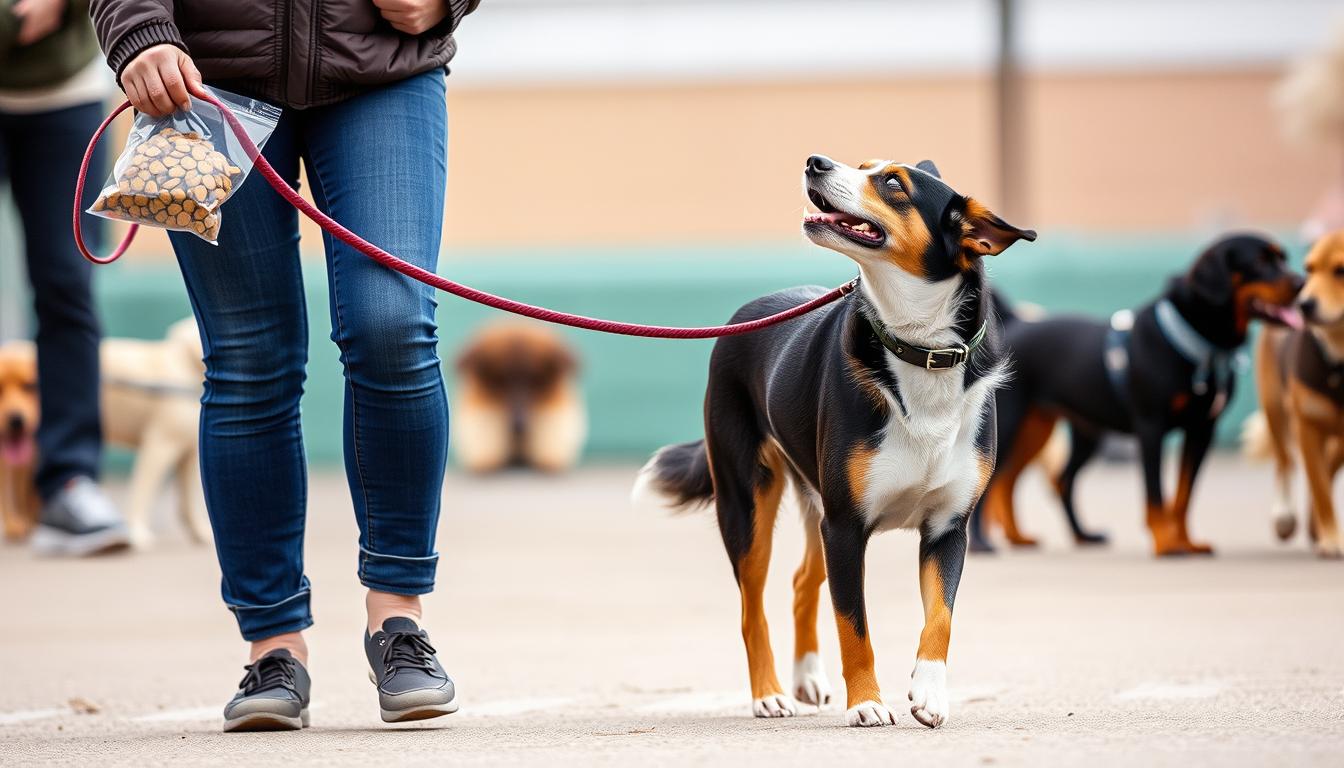Are you tired of being pulled around by your furry friend on walks? Training your dog to walk nicely on a leash can change everything. But, where do you begin?
Leash training makes walks enjoyable for you and your dog. Today, we’ll share key tips and methods for no-pull training. We’ll cover choosing the right leash and collar, and effective training steps. By the end, you’ll see why being consistent and patient is key in leash training. Are you ready to start? Let’s get going!
Understanding the Importance of Leash Training
Leash training is key for safe walks and keeping your dog in control. It keeps your dog close and safe during outdoor activities. When dogs pull on the leash, it can hurt both the pet and the owner. Strong pulls might cause falls or even road accidents, making leash training a must.
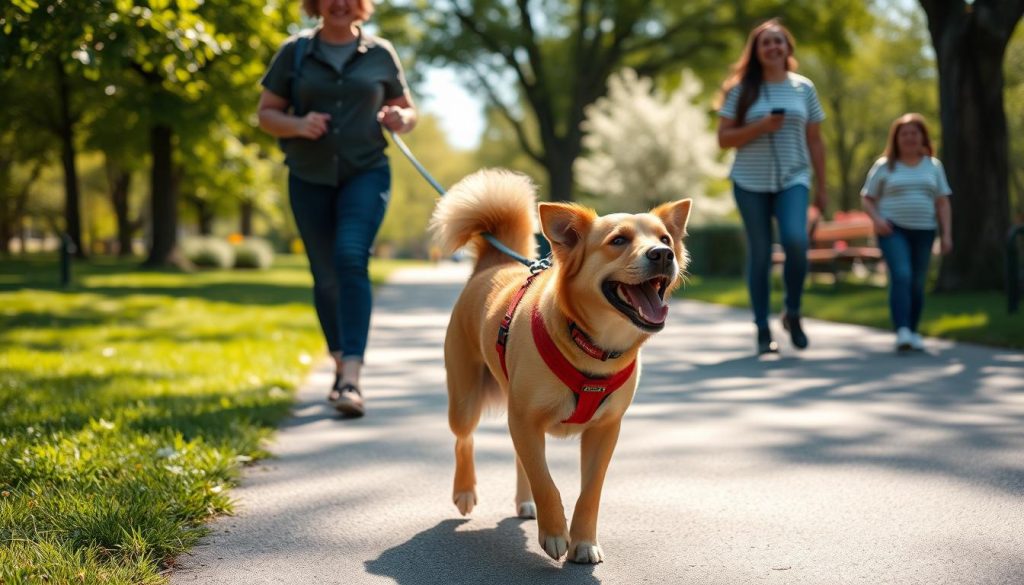
Teaching your dog to walk on a leash also makes walks better. A well-trained dog walks calmly by your side, making walks more fun, less stressful, and safer. This training is great for public places too. It helps your dog behave well around other dogs and people.
It’s also important to know about leash laws. In the U.S., some places require dogs to be on a leash. Following these laws shows you’re a responsible pet owner. It helps make the environment safer for everyone.
Quick Recommendation : Our blog is filled with tips , tricks, and methods for training your dog. If you are seeking a comprehensive training program, we recommend the K9 Training Institute.
Choosing the Right Leash and Collar
Choosing the right leash and collar is crucial for leash training. Different types of dog leashes and dog collars have their own benefits and drawbacks. It’s important to know what each one offers.
A standard leash is a common choice because it’s simple and lasts a long time. But, think about your dog’s size and strength. Big, strong dogs need a tough leash for safety and control. Smaller dogs might do better with a lighter leash.
Dog collars come in many styles, like flat, martingale, and choke chains. A flat collar works well for most dogs. But, if your dog likes to slip out, a martingale collar is a better choice. Use choke chains carefully and only with expert advice, as they can be dangerous if not used right.
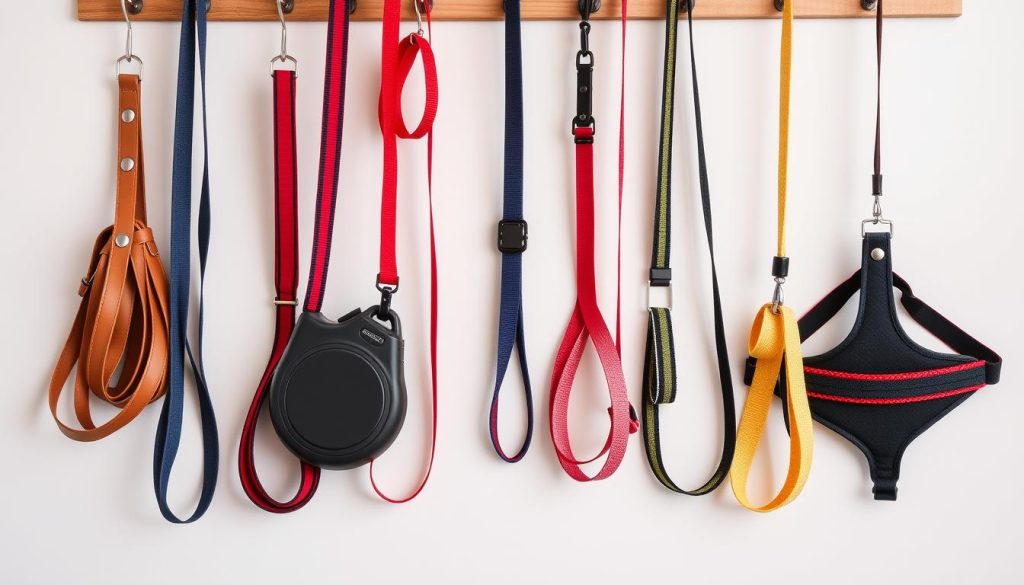
No-pull harnesses are great for dogs that pull a lot. They spread the pressure out over your dog’s body, helping prevent injuries and stopping pulling. They also have front clips that help you guide your dog back to you when they pull.
When picking between types of dog leashes and no-pull harnesses, think about your dog’s personality and how you walk. Energetic dogs might need a harness for better control. Calm dogs might be okay with a regular leash and collar.
The best choice depends on what you and your dog need. Trying out a few options can help you find the best fit for both of you.
Effective Training Techniques for Leash Walking
Leash training a dog can sometimes be tough, but the right approach helps a lot. Positive reinforcement is key. Use treats, praise, or toys to make leash walking fun for your dog. Start with commands like “heel” or “stop” to teach your dog well.
Begin training in a quiet place to keep your dog calm. Use clear and consistent commands. Reward your dog right away to help them learn faster.
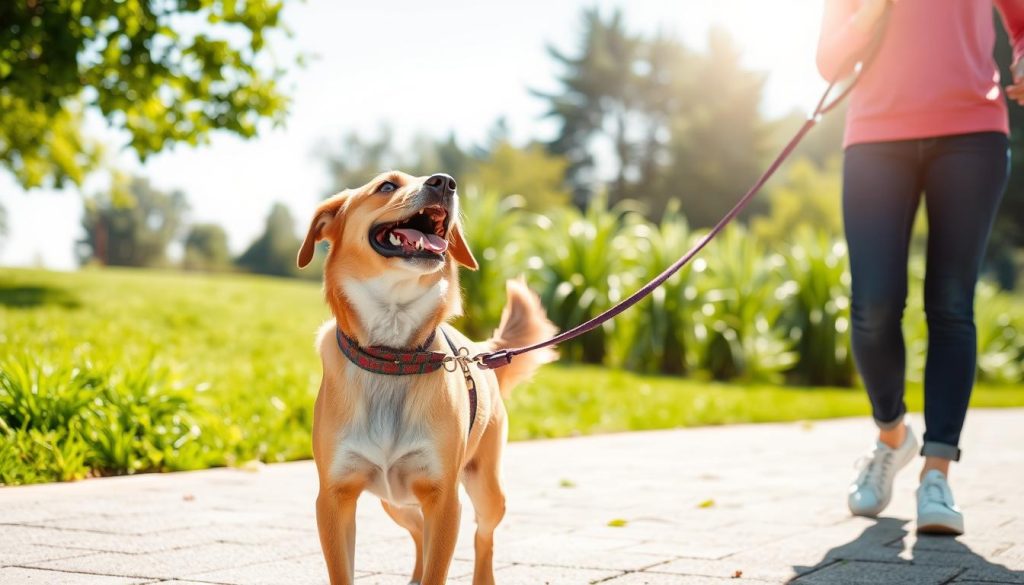
Stopping when your dog pulls is another good method. It teaches them that pulling doesn’t move you forward. Give them a treat when they walk by your side to encourage good behavior.
Use these techniques every day to make leash training work better. Practice leash training commands in different places. This will help your dog get really good at loose leash walking.
Using Treats and Rewards
Using treats and rewards is key to training your dog to walk nicely on a leash. This method, called treat-based training, uses positive reinforcement to encourage good behavior.
First, pick treats your dog loves. You might need to try a few different kinds to see what they like best. Small pieces of chicken or store-bought dog treats work well. The goal is to find treats your dog is excited to get.
It’s important to reward your dog right after they do the right thing. This helps them understand what they did to get the reward. For instance, if your dog stops pulling and walks by your side, give them a treat and say “Good job!” right away.
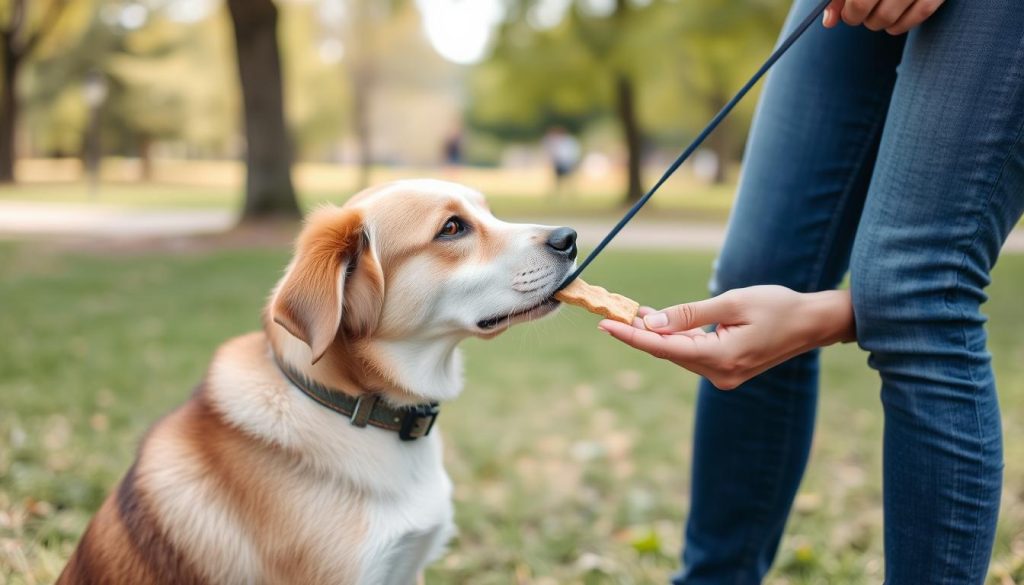
But don’t just use treats. Adding things like praise or a pat on the back can also help. Using a mix of these rewards makes training more fun and balanced. When your dog walks well on the leash, a simple “Good job!” or a scratch behind the ears can be a great reward.
Quick Recommendation : Our blog is filled with tips , tricks, and methods for training your dog. If you are seeking a comprehensive training program, we recommend the K9 Training Institute.
Practicing in Different Environments
To master leash walking, expose your dog to various walking spots. Begin with quiet streets to boost their confidence. Then, move to busier parks with more distractions. This step-by-step approach helps keep training consistent.
Try different routes like nature trails and pedestrian paths. These places offer new challenges and keep your dog engaged. It’s a great way to make training fun and effective.
Consistency is crucial when training in different places. Keep training sessions short and positive. Reward your dog for staying calm in various situations.
Dealing with distractions like cyclists, other dogs, and loud traffic is important. It will make your dog’s leash skills stronger. Training in different places helps your dog stay calm and obedient, making walks more enjoyable for both of you.
Addressing Common Behavioral Issues
Many dog owners face challenges like leash aggression, anxiety, and reactive dogs during leash training. It’s important to know what triggers these behaviors and how to handle them.
Leash aggression usually comes from frustration or fear. If your dog acts aggressively, stay calm and don’t pull them back. This can make things worse. Instead, help them get used to other dogs and things they find scary with slow steps and positive rewards.
Anxiety can show up when dogs are on walks in new places. They might pant a lot, shake, or avoid things. To help, stick to a regular routine for your dog. Use calming signs and slowly introduce them to new situations, rewarding them for staying calm.
For reactive dogs, figuring out what makes them react is key. This could be other dogs, loud sounds, or strange people. Try to keep them away from the trigger and use treats to distract them. Regular training and rewarding good behavior can lessen their reactions over time.
Dealing with these issues makes leash training easier and strengthens your bond with your dog. By understanding and managing leash aggression, anxiety, and reactivity, walks become more fun and less stressful for everyone.
Quick Recommendation : Our blog is filled with tips , tricks, and methods for training your dog. If you are seeking a comprehensive training program, we recommend the K9 Training Institute.
Tools to Aid Leash Training
Mastering leash training can be easier with the right dog training aids. These tools help you teach your dog to walk nicely on a leash without pulling.
Harnesses are a top choice for leash training. They spread the pressure across your dog’s chest and back, making them safer and more comfy than collars. No-pull harnesses help cut down on pulling by changing your dog’s direction.
Head collars are another great tool. They look like horse halters and fit around your dog’s nose and neck. When your dog pulls, the head collar gently turns their head back towards you, stopping them from moving forward. But, make sure it fits right and introduce it slowly to your dog to prevent any discomfort.
Other useful tools include training leashes, which are shorter for better control, and training treats bags, which keep rewards ready for positive reinforcement anywhere.
Each tool has its pros and cons. For instance, harnesses are great for controlling strong pullers but might not work for all breeds. Head collars are good for reducing pulling but some dogs need time to get used to them. So, picking a tool that fits your dog’s needs and personality is key.
Using the right dog training aids can make leash training easier and more successful. Always use these tools with positive reinforcement to make training fun and effective for your dog.
Consistency and Patience in Training
To train your dog to walk on a leash without pulling, consistency and patience are key. It’s important to have regular training schedules. This shows your dog that training is a serious and ongoing task.
Keep focusing on ongoing training and reward good behavior every time. Praising your dog or giving them treats helps them understand how to walk on a leash. Always stay patient and positive, even if progress seems slow.
Every dog learns at their own speed. With patience and consistency, you’ll see progress. This makes training a rewarding experience for you and your dog. Following consistent training schedules leads to long-term success in leash training.
Conclusion
In this guide, we’ve covered the key steps for leash training. You learned why it’s crucial for your dog’s safety and your peace of mind. We talked about choosing the right leash and collar for comfort and control.
We also discussed training methods like using treats and rewards to encourage good behavior. It’s important to practice in different places to help your dog adjust. This way, they’ll be better prepared for various situations.
Addressing issues like pulling and lunging is vital for successful training. We looked at tools that can help, but remember, consistency and patience are key. These factors are crucial for a well-behaved dog and enjoyable walks.
Successful leash training is about more than discipline. It’s about building a stronger bond with your pet. With the advice and tools shared here, you’re ready for better walks ahead. Start using these tips now and enjoy having a well-behaved dog by your side.
Quick Recommendation : Our blog is filled with tips , tricks, and methods for training your dog. If you are seeking a comprehensive training program, we recommend the K9 Training Institute.

